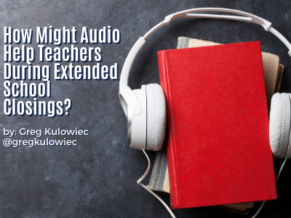by Greg Kulowiec
In these increasingly challenging times for educators, students and families, there has been an understandable focus placed on distance learning. While it is safe to say that this is not an ideal time to introduce new edtech tools to students, educators may want to consider the role that audio can play in enhancing communication with their students during prolonged school closures.
While creating and sharing audio has been challenging and often problematic in the past, there are three approaches that educators can take, with very little background experience, to begin leveraging audio to connect with their students, share information, and create a sense of community during this challenging time.
Audio & Google Slides:
Now open to all G Suite education domains, educators can use the “insert audio” feature in Google Slides to bring life to their digital assignments, presentations and course content. Elementary grade teachers can narrate short readings, high school history teachers can add audio hot spots on top of primary source excerpts and maps, and science teachers can provide insight into complex graphics and equations.
To insert audio into Google Slides follow the steps below:
- Record audio - consider using a site such as 123apps.com, which allows teachers to record & download mp3 files directly to their laptop.
- Upload the audio / mp3 file to Google Drive.
- In Google Slides: Insert - Audio. Tip: Make sure the audio is open to anyone in the domain. By default the audio file uploaded to Drive will be private. If the Slides are shared with the student, the audio will not play back unless it is made public in the school domain. Storing all of the audio files in one shared folder with the appropriate sharing settings can be an ideal way to streamline this workflow.
- Once inserted, select the audio & tap on “Format Options” to customize playback & appearance.
For more information on using audio in Google Slides, read this entire post by EdTechTeacher instructor Greg Kulowiec: Google Slides as Narrated Storybooks. Also, for additional ideas on how audio can be used in conjunction with Google Sites, check out The Power of Google Sites & Audio by EdTechTeacher instructor, Avra Robinson.
Synth:
Synth is an outstanding option for educators that want to quickly create short audio files, or “Synths” that are curated into a podcast that can be shared with a link to their students. Whether working from a laptop, Chromebook, or mobile device, educators can add approximately four minute audio synths to an existing podcast. This is an outstanding option for educators that want to be able to stay in close communication with students, but do not yet feel comfortable with audio editing.
To create a podcast on Synth:
- Go to gosynth.com & login with Google or create an account.
- In the top toolbar, select Podcast & Create Podcast.
- Copy the web link that is provided, and share the link with students via email, LMS, etc…
- With the podcast created, tap on the + icon to begin recording. Once the audio is recorded, it can be renamed & added to the podcast.
- The entire podcast can be shared with a link, or individual Synth segments can also be shared.
To learn more about educators who are using podcasting in education and how an educator from South Korea has been using Synth and audio during an extended school closing, consider watching this webinar.
Visit the Synth blog to also learn more about how educators can use this tool in their classrooms.
Anchor:
Anchor is a powerful podcasting tool that allows anyone to create a podcast from any device (laptop, Chromebook, phone, iPad) that can be broadcast across every major podcasting platform. From Spotify to Apple & Google podcasts, educators have the ability to connect with their students where they consume audio on their personal devices. Anchor is completely free, and there is no limit on the duration of a podcast episode. Creators have the ability to record directly in the Anchor episode builder on any device, or for those comfortable with audio editing in tools like Garageband and Soundtrap, mp3 files can be added into the episode builder.
While there are not any advanced editing features in the Anchor episode builder, background music, sound effects, and transitions are all available with a simple drag and drop. Once the first episode is published, it will appear immediately on the Anchor website and the show will have an Anchor URL. After a few days, the show will begin appearing on every major podcasting platform.
Consider the potential impact during an extended school closing where an educator could provide instructional content in the form of audio that can be consumed by students on any device.
Again, the introduction of new technology and new tools during an extended school closing has the potential to create challenges and roadblocks for students that are attempting to complete their work digitally. And while there are numerous equity and accessibility issues to consider, audio can play a beneficial role as educators are trying to navigate new waters during these challenging times.
If you found these ideas to be helpful, or have other suggestions around leveraging audio as an educator, please feel free to reach out to Greg:
@gregkulowiec

